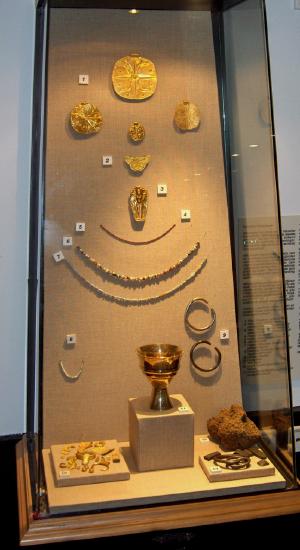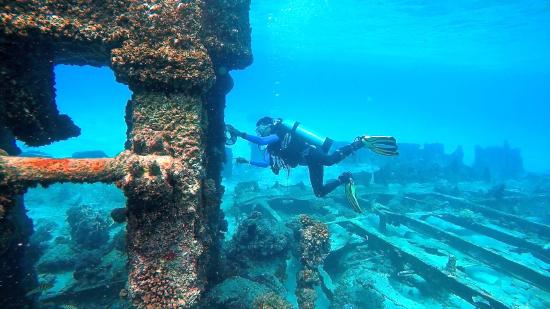8.0: Chapter Introduction
- Page ID
- 180533
Introduction: An Ancient Shipwreck Offers Historical Insight
In 1982, local sponge divers off the coast of Kas, Turkey, found and reported fragments from a shipwreck that appeared to be extremely old. They didn’t know it at the time, but the discovery would prove to be incredibly valuable—and not just because of the ship’s luxurious cargo, which included ebony, ivory, jewelry, cosmetics boxes, and gold-adorned bronze figurines, in addition to copper, tin, glass, wood, and a variety of food products (Figure \(\PageIndex{1}\)). The still-intact parts of the ship provided insight into the construction of ancient sailing vessels, including of the kind that might have been used in historic and legendary battles such as the Trojan War. Even more than that, the ship—which archaeologists date to sometime in the 14th century BCE, during the Bronze Age—shows a robust trade network between the cultures surrounding the Aegean and Mediterranean Seas. Known as the Uluburun Shipwreck, after the rocky Cape of Ulu Burun, where it sank without capsizing, the ship was excavated in 1984. Tens of thousands of dives brought up more than 17 tons of artifacts and valuable cargo, finished goods and raw materials from a variety of different regions. Archaeologists believe that the ship was on its way to Greece or western Turkey, carrying cargo from Syria, and with a stop in Cyprus (as evidenced by the copper ingots).

Thinking about the cross-cultural mix of international cargo on board, this sunken ship is also quite literally a cultural time capsule, capturing a distinct moment in time and helping to paint an interconnected history that is often overlooked and overshadowed by simplified historical timelines. As John Noble Wilford points out, this shipwreck occurred “approximately when Tutakhamen sat on the throne of Egypt, Troy flourished in Asia Minor and a brisk seagoing trade was conducted out of Syrian and Canaanite, or early Phoenician, ports.” The mix of artifacts aboard this vessel help to physically illustrate not only the overlapping cultures that existed contemporaneously, but also the ways in which these people could have interacted and traded.
This intersecting timeline is an especially important reminder for textbooks such as this one, because the course material does not move strictly chronologically. Within regions like the Ancient Near East or Egypt, the chapters generally move through the material from oldest to most recent—discussing the Palette of Narmer before the death mask of Tutankhamun, for instance). However, across regions, there is an overlap that is extremely important to point out. For instance, the Warka Vase is older than the Palette of King Narmer, but the Stele of Hammurabi is newer. The Snake Goddess in this chapter is newer than the Great Sphinx and older than Ashurbanipal Hunting Lions or the Ishtar Gate. The Met Museum’s online Heilbrunn Timeline of Art History is helpful in visually illuminating such intersecting occurrences.
Among the cargo on board the Uluburun Shipwreck were almonds, figs, grapes, and olives. The lands around the Aegean sea are rich and fertile, complemented by a particularly pleasant climate. With plentiful food, game, and seafood, the population flourished, and along with it large architectural complexes as well as smaller art objects, often celebrating the beauty of the land and sea. The Greek mainland and the Aegean islands, including Crete, exchanged raw goods, finished products, and ideas, among themselves and with their neighbors to the south and east.
The burgeoning field of nautical archaeology has helped to make great advances for the larger field of archaeology, in just the past sixty years. In 1960, Dr. George F. Bass began pioneering nautical or maritime archaeology, focusing specifically on careful and scientific processes for underwater excavations. In 1972, Bass helped to found The Institute of Nautical Archaeology (INA), a non-profit research organization responsible for overseeing the study and preservation of important shipwreck sites such as the Uluburun shipwreck, discussed in the introduction, and the Phoenician shipwreck at Bajo de la Campana, Spain. Just four years later, INA teamed up with Texas A&M University to establish the first Nautical Archaeology Program for graduate students pursuing an M.S. in Maritime Archaeology and Conservation or a Ph.D. in Anthropology.

Sunken ships and buried treasures help historians, anthropologists, archaeologists, and art historians to learn much about cultural connections made via international coastal trade routes. The excavation of the Byzantine Serçe Limanı Shipwreck (dated c. 1025 CE) offers great insight into cross-cultural artistic interaction in the Middle Byzantine period. And projects such as the Battle of Bạch Đằng Research Project aim to recreate maps of the cultural landscape associated with Vietnamese battles and warships lost in 1288 CE. The importance of this growing field is not to be underestimated.
Historiography (Writing History)
Obscure Genealogies, Thefts, and Forgeries
The first section of this chapter deals with the enigmatic white marble sculpture found in the Cycladic islands. Many of these islands, such as Delos, play a role in later Greek history and mythology, so archaeologists, art historians, and Greeks naturally thought of this prehistoric Cycladic sculpture as early Greek sculpture—although there is no evidence that the people who made or used it spoke any form of Greek. Nonetheless, since they were seen as predecessors to the highly-prized Greek art discussed in the following chapter, these sculptures were accorded particular significance. The fact that they were white marble, like classical Greek sculpture celebrated at the time,e added to their prestige and art market value. As this chapter and the next point out, however, neither these Cycladic sculptures, nor the later Greek ones, were originally white.
The clean lines and abstraction of these Cycladic sculptures became even more valuable as modern artists such as Constantin Brancusi and Amedeo Modigliani adapted them. The folded-arm figurines, or FAFs, were particularly attractive to 20th-century collectors—and unfortunately resulted in some unethical and truly destructive behavior, from robbing graves to creating fakes. For this reason, especially with these FAFs, it is very important to know the object’s provenance: where it came from, who found it, and what collections it has belonged to since then. Read more about authenticating these sculptures and displaying them at the Getty Museum in the additional suggested readings.
Mythic Inspiration
A legacy of myths and legends plays a particularly interesting role in this chapter. The names of heroes and monsters appear in geographical features (like “Aegean” itself), regions (like “Minoan”), and architectural terms (like “Cyclopean” masonry or “labyrinth”). Some of these myths come from Homer—the famed blind poet who, at least according to tradition, composed two epics around 750 BCE—though Homer’s stories and even many of his phrases are much older. The Iliad immortalizes the war between the Greeks and the Trojans, and the Odyssey describes the hero Odysseus’ adventure-filled journey back home. These two epics have been considered the first great works of “Western” literature, as Homer celebrated larger-than-life heroes of a bygone, golden era.
Until the late 19th century, Homer’s tales were believed to be entirely made up. After all, they involve the direct intervention of deities like Athena and Poseidon, and monsters like the six-headed sea monster Scylla and the one-eyed giant Polyphemus. The names of places and people were thought to be simply evidence of Homer’s impressive imagination. However, a few Europeans, including the amateur archaeologist Heinrich Schliemann, were convinced that these tales held at least a seed of historical accuracy. Schliemann used the texts to guide his excavations, and in 1876 he did find the site of ancient Troy, and later rich treasure at Mycenae. Unfortunately, he was not a trained archaeologist, and in his haste to locate the archaeological layer of the Troy of the Iliad and the Odyssey, he actually blasted—literally—right through it, though he did discover impressive objects much older than Homer’s Troy.
Contentious Restorations
The second portion of this chapter, focusing on Minoan art, highlights and foregrounds an important conversation about restoration, preservation, conservation, the role of archaeologists, and the ethics to which they are bound. Because of problematic and intrusive construction at Minoan sites such as Knossos, there are works covered in this chapter that have been “restored” to the extent that viewers cannot actually know what they looked like originally. Neither the Minoan Snake Goddess’s head nor her right arm is original, and the famous Bull-Leaping fresco is a collection of fragments that may not even have been originally located in the same room. Nevertheless, Knossos offers valuable historical reminders and possibly fodder for heated debates about the process of uncovering and preserving history.
Chapter Overview
Three Regions: Cycladic, Minoan, and Mycenaean
The chapter considers three cultures, divided by region: Cycladic, Minoan, and Mycenaean. Cycladic art is the art of the Cyclades, the small islands in the Aegean Sea that circle the island of Delos. You might recognize the Greek root, cycl-, from words also having to do with circles—such as bicycle, motorcycle, and cyclone. Minoan art is the art of Crete. The word Minoan comes from the mythical king of Crete named Minos. Finally, art of the Greek mainland is called Helladic, after its ancient—and modern—name, Hellas. Late Helladic art is called Mycenaean, after one of its important locations, ancient Mycenae.
Objects Overview
This chapter covers well-known works of art—some known precisely because of their controversial and even inaccurate restoration. The works in this chapter also give insight into the Aegean island cultures which were both peaceful and war-like, depending on time and circumstance. This chapter includes a wide range of metallurgy, architecture, sculpture, and vessels, including:
- small-scale Cycladic marble sculptures of people and animals
- the Minoan Palace at Knossos, which not only demonstrates architectural advancements such as the corbeled arch, but also tells the tale of contentious, controversial, and damaging restoration
- the Bull-leaping fresco, whose figures nod to an early example of fluid representations of gender
- the Hagia Triada Sarcophagus, the only Minoan sarcophagus which is fully painted
- fabulously detailed and playful Minoan Marine-Style pottery such as the Octopus Vase from Palaikastro
- the citadel site of Mycenae, which offers insight into a culture prone to war and in need of protection
- Mycenaean metallurgy, including fine examples of gold, silver, and bronze objects
- Mycenaean ceramic vessels, which varied in style and were popularly traded around the Mediterranean and found as far afield as Egypt, Asia Minor, and Spain
By the time you finish reading this chapter on Ancient Aegaean art, you should be able to:
- Differentiate between the art and architecture of Cycladic, Minoan, and Mycenaean cultures
- Identify visual aspects of Minoan art, architecture, and society
- Describe important Mycenaean architectural achievements and their cultural context
- Discuss the relationship between Minoan and Mycenaean art and culture
- Evaluate the role and ethics of archaeology, restoration, preservation, and conservation
Want to know more?
Here are some additional resources you can explore to further your understanding of the art discussed in this chapter.
- Mark Cartwright, Uluburun Shipwreck, for World History Encyclopedia
- John Noble Wilford, Treasure of Artifacts Found in 3,400-Year-Old Shipwreck, for The New York Times
- The Challenges of Underwater Excavation, for Google Arts & Culture
- Met Museum’s online Heilbrunn Timeline of Art History
- Suzanne Muchnic, “Getty Conservators Are On the Case : Art: The museum staff painstakingly determines the authenticity of Cycladic art before it is installed,” for Los Angeles Times
- Terracotta Krater at the Met Museum
- Matt Kaplan/TedEd, "The Scientific Origins of the Minotaur"
- Getty Museum (search their Cycladic objects)
- Homer's The Odyssey

